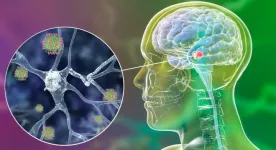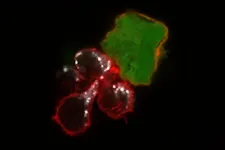INFORMATION:
Human molecule blocking toxic forms of Parkinson's-related protein identified
2021-06-29
(Press-News.org) The death of neurons specialised in the synthesis of dopamine, one of the brain's main neurotransmissors, deteriorates the motor and cognitive capacities of those with Parkinson's disease. The loss of these neurons is related to alpha-synuclein aggregation. Recent studies show that oligomers, the initial aggregates of this protein, are the most pathogenic forms of α-synuclein and are responsible for the spreading of the disease in the brain.
Therefore, one of the more promising approaches in fighting this disorder consists in neutralising these oligomers and, thus, slow down the pathological progression. However, the fact that these aggregates do not present a defined structure and that they are transitory by nature makes it extremely difficult to identify molecules that bind with enough strength as to explore any clinical application.
A scientific collaboration between researchers from the Institute for Biotechnology and Biomedicine (IBB) at the Universitat Autònoma de Barcelona (UAB) and from the Instituto de Biocomputación y Física de Sistemas Complejos (BIFI) of the Universidad de Zaragoza (UniZar) now has been able to identify a human endogenous peptide which strongly and specifically attaches to the α-synuclein oligomers, thus avoiding their aggregation and blocking their neurotoxicity, two processes closely related to the neurodegenerative decline of Parkinson's disease. The identification and study of the peptide, called LL-37, was recently published in Nature Communications.
"LL-37 interacts with the toxic alpha-synuclein oligomers in a selective manner and with a strength superior to that of any peptide previously described, equivalent to the strength exhibited by antibodies. It inhibits aggregation at very low concentrations and protects neuronal cells from being damaged", researchers point out.
They add that, "LL-37 is found naturally in the human organism, both in the brain and in the intestine, organs in which α-synuclein aggregation takes place in Parkinson's disease. This suggests that LL-37's activity might respond to a mechanism developed by the body itself as a means to naturally fight this disease."
Encouraged by this idea, researchers now want to study how its expression can be regulated and if this strategy can become a safe therapy with the potential of influencing the course of the disease. "There is a possibility that a therapy for Parkinson's disease already lies in our interior and that it only needs to be activated correctly", states Salvador Ventura, researcher at the IBB and coordinator of the study.
The identification of LL-37 was conducted under the framework of a research analysing the structure and characteristics of pathogenic oligomers with the aim of neutralising them in a specific manner. The analyses conducted demonstrate that helical peptides with a hydrophobic side and another positively charged side are ideal for this type of activity. The trials allowed researchers to identify three molecules with anti-aggregation activity: in addition to the human molecule, a second peptide present in bacteria and a third artificially made molecule were identified.
In addition to representing a possible therapeutic route for Parkinson's disease and other synuclein pathologies, the molecules identified in the study are promising tools for its diagnosis, given that they discriminate between functional and toxic α-synuclein species.
"Until now there were no molecules capable of selectively and efficiently identifying toxic α-synuclein aggregates; the peptides we present on these issues are unique and, therefore, have great potential as diagnostic and prognostic tools," says study co-coordinator Nunilo Cremades, researcher at BIFI-UniZar.
In the study, over 25,000 human peptides were computationally analysed, and single molecule spectroscopy methods, as well as protein engineering, were applied, in addition to cell cultures in vitro using toxic oligomers.
Participating in the study were researchers from the IBB-UAB and the Department of Biochemistry and Molecular Biology at the UAB Jaime Santos (first author of the article), Irantzu Pallarès and Salvador Ventura (co-coordinators of the study), members of the "Protein Folding and Conformational Diseases" group; and BIFI-UniZar researchers Pablo Gracia (second author of the article) and Nunilo Cremades (co-coordinator of the study, predoctoral researcher and lead researcher, respectively, of the "Amyloid Protein Misfolding and Aggregation" NEUROMOL group from the BIFI-Unizar.
ELSE PRESS RELEASES FROM THIS DATE:
Stock markets becoming increasingly networked due to high-frequency traders
2021-06-29
During the last twenty years, the trading in stock markets has undergone significant changes. Researchers from the University of Turku and the University of Palermo have investigated the role of high-frequency traders in the markets.
Technological evolution and innovations both in the technology used by stock exchanges and the resources of the traders using their services have made faster trading possible. As a result, high-frequency trading in sub millisecond scale has increased.
However, not everyone has the opportunity to use high-frequency trading, and generally, the scales can be anything from microseconds to tens of thousands of seconds. The role of high-frequency traders has given rise to broad debate over ...
People living with HIV/AIDS have a significantly higher risk of suicide
2021-06-29
HERSHEY, Pa. -- A new study by researchers at Penn State College of Medicine indicates that people living with human immunodeficiency virus (HIV) and acquired immune deficiency syndrome (AIDS) -- approximately 38 million worldwide -- are more likely to have suicidal thoughts and die from suicide than members of the general population. The researchers said that despite significant medical advancements related to HIV treatment and patients' quality of life, risk of suicide in these patients is high and health care providers should prioritize mental health screenings in this population.
According to the World Health Organization, roughly 800,000 people worldwide die from suicide annually. Among ...
Blood clots related to AstraZeneca/Oxford vaccine can be mitigated with early detection
2021-06-29
Tuesday, 29 June 2021 - New research has shown that early testing for blood clots in patients who had received the AstraZeneca/Oxford vaccine led to them being treated successfully, highlighting the need for heightened awareness of the risk among doctors.
The work, led by researchers from RCSI University of Medicine and Health Sciences and the National Coagulation Centre at St James's Hospital, is published in the British Journal of Haematology.
Unusual blood clots with low blood platelets have been recognised as a very rare complication of the AstraZeneca vaccine. However, with increased awareness, ...
RUDN University chemists create substances for supramolecules' self-assembly
2021-06-29
RUDN University chemists derived molecules that can assemble into complex structures using chlorine and bromine halogen atoms. They bind to each other as "velcro" - chlorine "sticks" to bromine, and vice versa. As a result supramolecules are assembled from individual molecules. The obtained substances will help to create supramolecules with catalytic, luminescent, conducting properties. The study is published in Mendeleev Communications.
Supramolecules are the structures made of several molecules. Individual molecules are combined, for example, by self-assembly or without external control. The resulting structure has properties that the molecules did not have individually. That is the way to create new materials, catalysts, molecular machines for ...
Scientists detect gravitational waves for first time from black holes swallowing neutron stars
2021-06-29
For the first time, scientists detected gravitational waves caused by mergers between black holes and neutron stars. Researchers from LIGO, Virgo, and KAGRA detected the two gravitational wave events--from distances of more than 900 million light-years away--within a span of 10 days in January 2020 during the second half of LIGO and Virgo's third observing run. Astrophysical Journal Letters published the results and their implications today: https://iopscience.iop.org/article/10.3847/2041-8213/ac082e.
Researchers from Rochester Institute of Technology's Center ...
LSL60101 compound reduces neuroinflammation and improves cognition
2021-06-29
The LSL60101 compound, a specific ligand of the I2-IR receptors in the brain, could shed light on the development of future strategies against Alzheimer's disease. This is stated in the recent studies by the Research Group on Medicinal Chemistry and Pharmacology of Neurodegenerative Diseases of the University of Barcelona, published in the journals European Journal of Medicinal Chemistry and British Journal Pharmacology. In studies carried out with mice, LSL60101 has improved the cognitive deficit and the biomarkers related to the disease in these animal models.
These studies result from the collaboration of the research teams led by professors Carmen Escolano, from the Faculty of Pharmacy and Food Sciences and the Institute of Biomedicine of the UB ...
Just enough information will motivate young children to learn, drive curiosity
2021-06-29
Preschool children are sensitive to the gap between how much they know and how much there is to learn, according to a Rutgers University-New Brunswick study.
The research, published in the journal END ...
Mongoose in the city: How landscape can impact disease transmission in Botswana
2021-06-29
Under a concrete drainage culvert at the edge of a town in Botswana, a troop of banded mongoose is getting ready to leave its den. Moving from shade into light, the cat-sized animals scan the area for signs of danger and for opportunities to find something to eat in an increasingly crowded neighborhood.
Unbeknownst to them, the genetics of this troop's members -- and others like them -- are providing researchers in the College of Natural Resources and Environment with new understandings of how and why animal behavior changes in proximity to human development and how that change can impact infectious disease spread.
The researchers used genetic tools to identify changes in movement behavior among mongooses ...
Cell-based immunotherapy shows promise against melanoma
2021-06-29
An immunotherapy based on supercharging the immune system's natural killer cells has been effective in treating patients with recurrent leukemia and other difficult to treat blood cancers. Now, researchers at Washington University School of Medicine in St. Louis have shown in preclinical studies conducted in mice and human cells that this type of cell-based immunotherapy also could be effective against solid tumors, starting with melanoma, a type of skin cancer that can be deadly if not caught early.
The study is published June 29 in Clinical Cancer Research, ...
AAFP releases updated feline senior care guidelines to the veterinary community
2021-06-29
[BRIDGEWATER, NJ; June 29, 2021] The American Association of Feline Practitioners (AAFP) has released the updated 2021 AAFP Feline Senior Care Guidelines to be published in the July issue of the Journal of Feline Medicine and Surgery. This update provides emerging advances in feline medicine with respect to the aging cat. The Task Force of experts provides a thorough current review in feline medicine that emphasizes the individual senior patient.
As defined in the 2021 AAHA/AAFP Feline Life Stage Guidelines, cats over 10 years of age are considered to be 'senior.' Understanding the changing needs of each individual senior cat is critical for both veterinary professionals and cat owners. "Veterinary professionals are encouraged to use the 2021 ...





